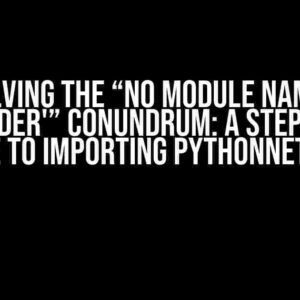If you’re struggling with slow S3 uploads when trying to upload multiple files in parallel using aioboto3, you’re not alone. Many developers have faced this issue, and it’s time to put an end to it. In this comprehensive guide, we’ll dive deep into the world of aioboto3 and S3 uploads, exploring the reasons behind slow uploads and providing you with actionable solutions to optimize your upload process.
The Problem: Slow S3 Uploads with AIoboto3
AIoboto3 is a popular Python library that allows you to interact with AWS services, including S3, using asynchronous I/O. While it’s an excellent tool for uploading files to S3, it’s not immune to performance issues. When uploading multiple files in parallel, you might notice that the upload process is slower than expected. This can be frustrating, especially when working with large files or tight deadlines.
Why Do Slow S3 Uploads Happen with AIoboto3?
There are several reasons why you might experience slow S3 uploads with aioboto3:
- Network Congestion:** When uploading multiple files simultaneously, your network connection might become congested, leading to slower upload speeds.
- Resource Constraints:** If your system lacks sufficient resources (e.g., CPU, memory, or disk space), it can struggle to handle the concurrent upload process, resulting in slower uploads.
- S3 Throttling:** AWS S3 has built-in throttling mechanisms to prevent abuse and maintain performance. If you exceed these limits, your upload speeds will be reduced.
- AIoboto3 Configuration:** Improper configuration of aioboto3 can lead to suboptimal performance.
Optimizing AIoboto3 for Fast S3 Uploads
Now that we’ve identified the potential causes of slow S3 uploads, let’s explore the solutions to optimize aioboto3 for fast and efficient uploads.
1. Configure AIoboto3 for Concurrent Uploads
To take full advantage of aioboto3’s asynchronous capabilities, you need to configure it for concurrent uploads. You can do this by:
import aioboto3
# Create an aioboto3 session
session = aioboto3.Session()
# Set the maximum number of concurrent connections
session.max_connections = 10
# Create an S3 client
s3 = session.client('s3')
In this example, we set the maximum number of concurrent connections to 10. You can adjust this value based on your system’s resources and network conditions.
2. Use Asynchronous Uploads with aiofiles
Aiofiles is a library that provides asynchronous file I/O operations. You can use it in conjunction with aioboto3 to upload files asynchronously:
import aiofiles
import aioboto3
async def upload_file(file_path, bucket_name, key):
async with aiofiles.open(file_path, 'rb') as f:
contents = await f.read()
s3.put_object(Body=contents, Bucket=bucket_name, Key=key)
# Create a list of files to upload
files_to_upload = ['file1.txt', 'file2.txt', 'file3.txt']
# Create a list of coroutines for each file
coroutines = [upload_file(file, 'my-bucket', file) for file in files_to_upload]
# Run the coroutines concurrently
await asyncio.gather(*coroutines)
In this example, we use aiofiles to read the file contents asynchronously and then upload them to S3 using aioboto3.
3. Implement Exponential Backoff and Retry
When uploading files to S3, you might encounter temporary errors or throttling. To handle these situations, implement exponential backoff and retry mechanisms:
import aioboto3
from botocore.exceptions import NoCredentialsError
async def upload_file(file_path, bucket_name, key):
retry_count = 0
max_retries = 5
backoff_seconds = 2
while retry_count < max_retries:
try:
s3.put_object(Body=open(file_path, 'rb'), Bucket=bucket_name, Key=key)
return
except NoCredentialsError:
# Handle credential errors
pass
except Exception as e:
# Handle other exceptions
print(f"Error: {e}")
# Exponential backoff
await asyncio.sleep(backoff_seconds ** retry_count)
retry_count += 1
print("Upload failed after max retries")
In this example, we implement an exponential backoff and retry mechanism to handle temporary errors or throttling. If the upload fails, we wait for a certain amount of time (doubling the wait time for each retry) before retrying the upload.
4. Monitor and Analyze Performance Metrics
To optimize aioboto3 for fast S3 uploads, you need to monitor and analyze performance metrics. This will help you identify bottlenecks and make data-driven decisions:
import aioboto3
# Create an S3 client
s3 = aioboto3.client('s3')
# Upload a file
s3.put_object(Body=open('file.txt', 'rb'), Bucket='my-bucket', Key='file.txt')
# Get the performance metrics
metrics = s3.meta.client._endpoint_operation_model.get_response_metadata()
print("Upload duration:", metrics['Duration'])
print("Upload speed:", metrics['HTTPHeaders']['Content-Length'] / metrics['Duration'])
In this example, we retrieve the performance metrics for the upload operation, including the duration and upload speed. You can use these metrics to optimize your upload process and identify bottlenecks.
Additional Tips for Fast S3 Uploads
Besides configuring aioboto3 and implementing the solutions mentioned above, here are some additional tips to help you achieve fast S3 uploads:
- Use S3 Acceleration:** Enable S3 Acceleration to reduce upload times by using Amazon CloudFront’s globally distributed network of edge locations.
- Leverage S3’s Multipart Upload:** Use S3’s multipart upload feature to upload large files in parallel, reducing the overall upload time.
- Optimize Your Instance:** Ensure your instance has sufficient resources (CPU, memory, and disk space) to handle the concurrent upload process.
- Use a Fast Network Connection:** Ensure a fast and stable network connection to reduce upload times.
Conclusion
Solving the issue of slow S3 uploads with aioboto3 requires a deep understanding of the underlying causes and a combination of configuration tweaks, coding optimizations, and performance monitoring. By following the guidelines and solutions outlined in this article, you’ll be able to optimize aioboto3 for fast and efficient S3 uploads, ensuring your applications operate at peak performance.
| Solution | Description |
|---|---|
| Configure AIoboto3 for Concurrent Uploads | Set the maximum number of concurrent connections to optimize aioboto3 for parallel uploads. |
| Use Asynchronous Uploads with Aiofiles | Utilize aiofiles to read file contents asynchronously and upload them to S3 using aioboto3. |
| Implement Exponential Backoff and Retry | Handle temporary errors or throttling by implementing exponential backoff and retry mechanisms. |
| Monitor and Analyze Performance Metrics | Track performance metrics to identify bottlenecks and make data-driven decisions. |
By applying these solutions, you’ll be able to overcome the challenges of slow S3 uploads with aioboto3 and ensure fast, efficient, and reliable file uploads to S3.
Frequently Asked Questions
Got stuck with slow S3 uploads when trying to upload multiple files in parallel with aioboto3? We’ve got you covered! Check out these frequently asked questions and their answers to get back on track.
Why is my S3 upload speed slow when uploading multiple files in parallel with aioboto3?
This could be due to the limitation of concurrent connections to S3. By default, aioboto3 uses a single thread and connection to upload files. To speed up the process, try increasing the concurrent connections by setting the `max_pool_connections` parameter when creating the `aioboto3` client.
Can I use multiple threads to upload files in parallel with aioboto3?
While aioboto3 is built on top of asyncio, which supports asynchronous I/O, it’s not designed for concurrent uploading of files using multiple threads. However, you can use the `concurrent.futures` module to create a thread pool and upload files in parallel using multiple threads.
How do I handle retries and errors when uploading multiple files in parallel with aioboto3?
aioboto3 provides built-in retry mechanisms for handling errors. You can configure the retry logic by setting the `retries` parameter when creating the `aioboto3` client. Additionally, you can use try-except blocks to catch and handle specific errors, such as network errors or S3 errors.
What’s the best way to monitor and track the upload progress of multiple files with aioboto3?
You can use the `tqdm` library to track the upload progress of multiple files. Wrap your upload function with `tqdm` to display a progress bar. Additionally, you can use logging mechanisms, such as AWS CloudWatch Logs, to monitor and track the upload process.
Are there any best practices for optimizing S3 uploads with aioboto3 for large files and high-performance applications?
Yes! For large files and high-performance applications, consider using multipart uploads, which can significantly improve upload speeds. Additionally, use a larger chunk size, enable server-side encryption, and optimize your instance type and network configuration for better performance.



